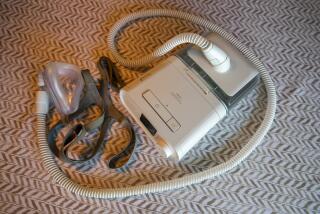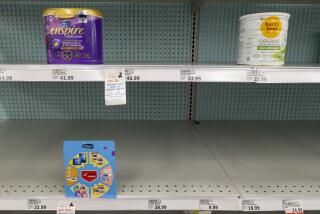Women Can’t Count on the FDA
- Share via
The Food and Drug Administration is known worldwide for having the most rigorous safety standards. Unfortunately, it lowered its standard last month when it approved saline-filled silicone breast implants. That decision will have an impact on the lives of as many as 150,000 women and teenage girls who get those implants each year. And if implant makers have their way, the FDA will approve even riskier silicone gel-filled implants next.
To win approval of their saline implants, two Santa Barbara-based corporations presented the FDA with results of their studies of women who got saline implants three to four years ago. They claimed their patients were satisfied, but reported serious problems such as broken implants, breast pain, infection, deformity and additional surgeries to fix those problems.
The manufacturers touted their implants’ safety, and they were backed up by plastic surgeons, who told the FDA about the wonderful successes in their practices. Like the children of Garrison Keillor’s mythical Lake Wobegon, the surgeons all seemed to be “better than average,” with complication rates that were much lower than the research found and patients more enthusiastic about the changes implants made.
Yet analysis by FDA scientists showed that the manufacturers and physicians had underestimated the true rates of complications. Using data gathered by the manufacturers, the FDA calculated that for one manufacturer, Mentor Corp., 43% of women who got implants for augmentation had at least one complication within three years. For mastectomy patients, it was even worse: Within three years, 73% of women who got implants had at least one complication, and 27% had their implants removed. The statistics were even more troubling for the implants made by McGhan Medical. For both brands, the FDA explained that the complication rates were still rising when the studies were completed, so the long-term health risks are unknown.
The FDA also heard heart-wrenching testimony from women with health problems due to saline breast implants. They heard from women who got sick but are too poor because of extensive medical bills to have the implants removed. They heard from women who were denied health insurance because they were considered high-risk due to their implants and subsequent complications. They heard from women whose symptoms did not improve until after their implants were removed. The FDA utterly ignored these devastating stories.
The FDA also heard a radiology expert testify that breast implants can interfere with mammography. Failure to detect cancer is twice as likely for women with implants. Of the 1.5 million to 2 million women with implants, it is likely that the breast cancer diagnosis of 20,000 to 40,000 of them could be delayed because their implants obscured a tumor. Such a delay can be deadly. When breast cancer is detected and treated in its earliest stages, 90% to 95% of those women are healthy 10 years later. Only 40% live 10 years if the cancer is more advanced.
Although the health risks clearly outweigh the cosmetic benefits for most women and teenage girls, the FDA approved saline implants anyway. The FDA will require that manufacturers provide detailed information about the risks to patients, but what does that mean? Will companies that misrepresented their data to the agency realistically portray the risks to their potential customers? It doesn’t look likely.
Instead, the manufacturers are looking for more business. After the FDA announced its approval of saline implants, McGhan boasted that it would seek FDA approval for silicone-gel implants. The FDA’s own research proves that this would be a tragic mistake. Scientists found that even among women who had not sought medical treatment for implant problems, almost 80% had at least one broken implant after 10 to 15 years. Even more worrisome, the silicone was migrating away from the implants in 21% of those women.
The FDA made no effort to publicize those results. Instead, it issues no warnings and still permits unapproved silicone-gel implants to be sold.
Consumers should have the peace of mind that the term “FDA approved” means that a product has been thoroughly tested and proved safe. Unfortunately, when it comes to breast implants, the FDA has placed the burden on women instead. Women will have to sift through the plastic surgeons’ and manufacturers’ glossy promotional brochures to seek the information they need because we can no longer rely on the FDA to look out for us.






